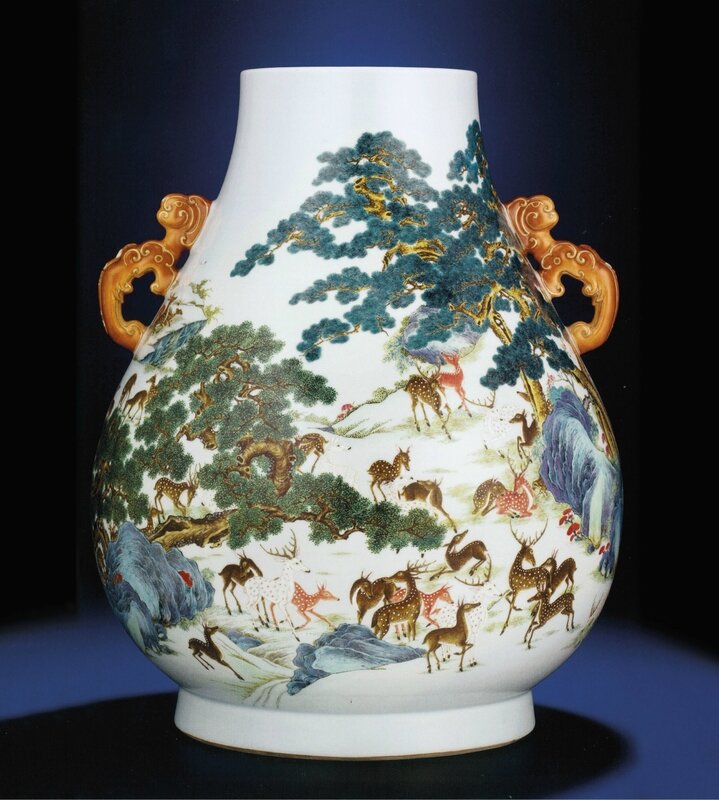A Magnificent famille Rose 'Hundred Deer' Vase, hu, Qianlong six-character seal mark and of the period (1736-1795)
Lot 2124. A Magnificent Famille Rose 'Hundred Deer' Vase, hu, Qianlong six-character seal mark and of the period (1736-1795); 17 1/2 in. (44.4 cm.) high. Estimate $1,100,000 - $1,500,000. Price Realized $1,246,352. © Christie's Image Ltd 2013
Of archaistic form, the full-bodied vase is superbly painted in vivid enamels with a herd of deer, comprising bucks, does and their young with reddish-brown fur, spotted hide and dappled white coats. The deer are grazing, gambolling and resting in a lush landscape, amidst pine and peach trees, lingzhi, and a meandering stream flowing through blue-shaded rocks from high mountains in the distance. The tapering sides are set with a pair of stylised dragon handles picked out in iron-red and gilt, wood stand.
Provenance: Offered at Sotheby's Hong Kong in 1984, and later acquired by the present owner in Hong Kong in 1987
Property from a Private American Collection
Notes: The 'hundred deer' motif was very popular as the landscape depicted contains important symbolic references. The subject of deer has a long history in Chinese art as it refers to the rebus where the Chinese word for 'deer' is a homophone for 'emolument' or 'civil service salary'; the 'hundred deer' therefore represent the ultimate success, a career in government service in Imperial China. The deer is also associated with Daoism and the Star God of Longevity, Shoulao, while the inclusion of peaches and lingzhi fungus in the decoration is further symbolic of longevity. As such, the subject-matter on the present vase alludes to a multitude of auspicious connotations.
The picturesque scenes of deer in rocky, tree-strewn landscape were probably intended to represent deer in the imperial gardens and hunting parks. Indeed, one of the reasons for the popularity of deer in Chinese art is assocated with a favourite imperial pastime - the creation of gardens and hunting parks, which were frequently stocked with deer. The Manchu Qing dynasty were proud of their heritage and encouraged equestrian and hunting skills. The Qianlong Emperor revived the tradition of the annual Autumn Hunt, and the Summer Palace at Chengde was largely a hunting park kept stocked with game, particularly deer. Deer and deer hunts were favourite themes in Qing dynasty court painting, as exemplified by a hanging scroll by the Jesuit Giuseppe Castiglione (1688-1768) which was exhibited at the Royal Scottish Museum, Edinburgh, 1996.
Fig.1 Giuseppe Castiglione (1688-1768), Deer (detail)
Examples of hu-shaped vases with this exquisite design are in various museum and private collections: one from the Beijing Palace Museum, is illustrated in Porcelains with Cloisonne Enamel Decoration and Famille Rose Decoration, The Complete Collection of Treasures of the Palace Museum, Hong Kong, 1999, pp. 98-99, pl. 85; a pair is in the Shanghai Museum, illustrated in Selected Ceramics from the Collection of Mr. and Mrs. J.M. Hu, Shanghai, 1989, pl. 67; a single vase, also in the Shanghai Museum, is illustrated in Chugoku Toji Zenshu, vol. 21, Kyoto, 1981, pl. 103; and in the Hong Kong Museum of Art Collection, included in the exhibition, The Wonders of the Potter's Palette, Hong Kong, 1984, illustrated in the Catalogue, p. 119, no. 71. Compare also with three other similar vases, the first from the British Rail Pension Fund was sold at Sotheby's Hong Kong, 16 May 1989, lot 89; and the second, from the collection of a medical doctor who worked in the German embassy in Beijing during the early 20th century, was sold at Christie's Paris, 14 December 2011, lot 170; and the third, from an American private collection acquired in Minnesota, was sold at Christie's Hong Kong, 30 May 2012, lot 3990.
Rare et important vase 'Cent daims' en porcelaine de la famille rose, hu, Chine, dynastie Qing, marque à six caractères en cachet et époque Qianlong (1736-1795). Lot vendu €2,025,000. © Christie's Images Ltd 2011
A Magnificent Famille Rose 'Hundred Deer' Vase, hu, Qianlong six-character seal mark and of the period (1736-1795); 17 1/2 in. (44.5 cm.) high. Sold for HKD 14,660,000 at Christie's Hong Kong, 30 May 2012, lot 3990. © Christie's Image Ltd 2012
There appear to be a number of 'deer' vases with slightly different variations in their design. Another variation on the same shape and theme but with blue and yellow enamelled handles are known, such as the example in the Nanjing Museum included in the joint exhibition with The Chinese University of Hong Kong,Qing Imperial Porcelain, 1995, illustrated in the Catalogue, no. 86. A pair in the National Palace Museum, is illustrated in Stunning Decorative Porcelains from the Ch'ien-lung Reign, 2008, pp. 156-157, no. 51. Another example is the Seikado Bunko Art Museum, illustrated in Shincho Toji, Keitokuchin Kanyo no Bi, 'Ceramics of Qing Dynasty, Beauty of Jingdezhen Imperial Kiln', Tokyo, 2006, p. 68, no. 58; and published with a deer vase without the handles, p. 69, no. 59. A vase from the Earls Cowper Collection, where the depiction of the deer themselves are larger in size and fewer in number, was sold at Christie's London, 13 May 2008, lot 224. Compare also to a related deer vase with puce-enamelled handles, sold at Christie's London, 10 May 2011, lot 299.
Christie's. IMPERIAL SALE; IMPORTANT CHINESE CERAMICS AND WORKS OF ART. 29 May 2013. Convention Hall.

/https%3A%2F%2Fprofilepics.canalblog.com%2Fprofilepics%2F1%2F0%2F100183.jpg)
/https%3A%2F%2Fstorage.canalblog.com%2F03%2F02%2F119589%2F96711876_o.jpg)
/https%3A%2F%2Fstorage.canalblog.com%2F11%2F31%2F119589%2F94773502_o.jpg)
/https%3A%2F%2Fstorage.canalblog.com%2F20%2F83%2F119589%2F94772815_o.jpg)
/https%3A%2F%2Fstorage.canalblog.com%2F26%2F72%2F119589%2F75604929_o.jpg)
/https%3A%2F%2Fstorage.canalblog.com%2F59%2F60%2F119589%2F26458628_o.jpg)








/http%3A%2F%2Fstorage.canalblog.com%2F91%2F48%2F119589%2F128923043_o.jpg)
/http%3A%2F%2Fstorage.canalblog.com%2F84%2F09%2F119589%2F128922928_o.jpg)
/http%3A%2F%2Fstorage.canalblog.com%2F74%2F57%2F119589%2F128709421_o.jpg)
/http%3A%2F%2Fstorage.canalblog.com%2F96%2F72%2F119589%2F128683141_o.jpg)